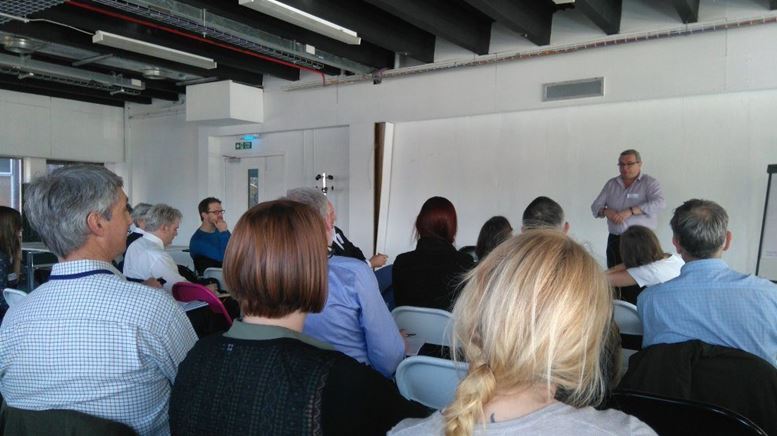Beyond Protected Areas
April’s “Pie And A Pint” (PAAP) night saw lively discussion between BES Scottish Policy Group members, NGO representatives, Scottish Government civil servants, and local political party candidates, focussing on one thing: protecting biodiversity both within and outside protected areas, and how we can make protected areas work better for biodiversity and people.

“Beyond Protected Areas” was the SPG’s largest PAAP to date and we were joined by Adam Smith (Game and Wildlife Conservation Trust), Davy McCracken (Scotland’s Rural College), Andrew Bauer (NFU Scotland) and Lloyd Austin (RSPB) who each presented their views and perspectives on conserving biodiversity both within and outside protected areas. There was general agreement among the speakers that protected areas are not currently working that well at protection; our task during the PAAP was to try and build consensus from everyone present as to how the situation can be improved. During our discussions we focussed on Protected Areas on land, but of course Protected Areas also encompass marine environments, and non-natural environments such as historical buildings.
The concept and designation of Protected Areas represents a core effort from all those using the land and sea, whether for economic or enjoyment purposes, to protect nature more widely. Working to make Protected Areas as effective as possible will provide a host of benefits such as providing space for nature, boosting peoples’ wellbeing and health, as well as ecosystem service provision, and enabling the natural environment to be as resilient as possible to future pressures, such as from climate change and invasive species.
One of the current issues is that Protected Areas are covered by strict rules in terms of land use and management, and this ‘one size fits all’ approach can lead to differential levels of conservation success (and failure) within them. When Protected Areas are first designated, they are done so at a specific snapshot in time to conserve e.g. high levels of biodiversity present at a site. It may be that since designation certain land-use practices, which were responsible for the initial high levels of biodiversity, are no longer as effective, leading to biodiversity declines. Stringent ‘one size fits all’ rules could be stifling more adaptive land management practices, which could be tailored to individual Protected Areas to maximise biodiversity conservation. Could harnessing the knowledge of resident farmers and land managers be a way to adaptively manage land within (and outside) Protected Areas for conservation, for the benefit of both biodiversity and people reliant on the same land?
.@scotgrouse as ecologists we need to help managers to monitor and adapt management @BES_ScotPol #pieandapint pic.twitter.com/h7GcbYvPBB
— Nils Bunnefeld (@bunnefeld) April 20, 2016
Managed land can be hugely beneficial to wildlife and ecosystem services, such as ‘high nature value farmland.’ Where such high nature value land exists outside Protected Areas, it could act as a stepping stone or corridor linking several Protected Areas together, and thus increase their effectiveness as species can more easily move between Protected Areas. It seems logical that where agri-envrionmental management is already working well, it should be encouraged to be continued for the benefit of wider conservation.
Unfortunately, “no change needed here” is a difficult sell to funding bodies that often require quantifiable changes in e.g. species richness, populations of threatened species, or expansion of desirable habitat types to justify funds awarded. Relying on the good will of land managers to maintain land in a high conservation-value state, when they may be losing out on productive land area, doesn’t really seem fair. Is there a better way to incentivise and reward land managers who are already using successful agri-envrionmental approaches, and encourage more to do the same?
.@DavyMcCracken we need to pay farmers to CONTINUE (not always change) to benefit nature conservation @BES_ScotPol pic.twitter.com/U1bRYa9YNB
— Nils Bunnefeld (@bunnefeld) April 20, 2016
During the PAAP there was a general feeling that we can’t carry on doing things as we always have done, but that there are aspects of Protected Areas that do work. The future of Protected Areas needs to be supported by everyone: the public, land managers, scientists, and politicians. By working together and developing new ways to communicate between Protected Area stakeholders, a roadmap of the future of Protected Areas in Scotland can be developed. Following our speakers’ presentations we broke out into discussion groups to try and answer some specific questions to try and build consensus on
i) How can we make Protected Areas as effective as possible?
ii) How do we ensure connectivity between Protected Areas?
iii) How do we conserve nature outside of Protected Areas?
Outcomes from group discussions are currently being collated by the SPG and written as a report, giving a tangible outcome from April’s PAAP directly resulting from discussions involving SPG members, MSPs, NGOs and scientists.
Do you have any comments and recommendations you would like to feed in to the three questions on Protected Areas?
Interested in the next PAAP? Become a member of the SPG and follow @BES_ScotPol on Twitter – see you there!
Like what we stand for?
Support our mission and help develop the next generation of ecologists by donating to the British Ecological Society.